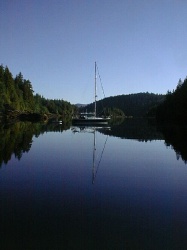| Anchors, Lines and
Windlasses: |
| We have tried a number of
anchors over the years and have settled on a 15KG (33 lb.) Bruce anchor with 50
feet of chain and 500 feet of 5/8 double braid nylon rode. This
anchor is indestructible, will turn and reset without coming out and is
good for clanking over the edge of a rocky drop-off with a sternline to
the beach. It held us for over 12 hours of 50 knots with furious gusts
at Snow Pass Alaska in the summer of 1998; Conditions that would surely
have completely wrecked the Danforth anchor that we once bent in a minor
blow.
We have a small electric windlass to haul
the rode. It, unfortunately, does not have a chain wheel so the last of
the chain and anchor must be pulled by hand. |
| |
| Fenders: |
| For tying alongside a wharf
and rafting to other vessels, we have found that the large round
"Scotchman" fenders are best. They roll rather than rub and
squeak and are large enough to absorb those sudden heavy impacts from
boat wakes. The exception is when tied alongside a logboom where
we use three 8 inch tubular fenders weighted at the bottom with 5 lb
steel shackles.
|
 |
|
| Stern Line: |
| We often anchor close ashore
with a stern line to the beach. The line is two 500 foot lengths of
inexpensive 1/2 yellow poly rope with spliced eyes on both ends so they
can be joined with a shackle. This stuff is easily tangled into a
nasty, knotty snarl if you wrap it up. The solution is to coil it into a
large plastic "laundry tub'. The line never tangles and will pay
itself out of the tub as you take the line ashore. The shore end
of the line has an eye slice and is connected using a stainless steel
shackle, not a knot.
Looping the line around a tree and taking
it back to the boat is generally a pain in the ass and when you do go to
release it without going ashore you have a fifty-fifty chance of it
snagging on something. We don't do it. When setting the anchor for
a stern tie we always try to place it so that if things get really out
of hand we can chuck the stern line and swing out into open water to
ride downwind.
|
| |
| Skiff Beach Line: |
| A 100 foot line of 3/8 inch
soft nylon with a quick connect clip serves as the shore line and tow
line for the skiff. A small, folding grapple anchor is useful for
broad sandy beaches and mudflats. |

|
|
| Logboom Ties: |
| Generally, don't tie to
either "end" of a logboom, particularly bundle booms. As
the boom moves with tide and wind the ends of logs may be driven with
great force over or under the head or tail end boomsticks and into the
hull of anything tied alongside..
|

|
|
Logbooms seldom have
convenient points to tie to so we carry a collection of log
"dogs" which can be driven into the boomstick to provide
mooring eyes as required. They are easily driven and removed with
a light hatchet that we carry aboard.
|
|
| After a fiasco where we both
almost ended up swimming in Kwatna Bay while tying to a very slimy and
exquisitely slippery standing boom, much to the amusement of the tug
crew tied nearby, we now carry a pair of rubber caulk boots aboard. TIP:
In this situation, if you don't have caulks the best bet is to lose
whatever footwear you have on and head out in your woolly socks. |
|
|
|